For Learning and Development (L&D) professionals, the ability to align training with the business strategy and needs is a prized talent. Seasoned L&D professionals understand that upskill and reskill employees within an enterprise are equivalent to 'upgrading' the organization's shared goals, collective skills, and operational efficiency.
For organizations looking to upskill and reskill their employees, a strategic organizational approach can help.
Instead of viewing L&D programs as an isolated and employee-centric exercise, enterprises need to view it from a company-benefiting lens. Driving an L&D program is not only beneficial for employees but can also sustain and advance the company's growth and bottom line.
Why Marry Organization Goals with L&D Upskill and Reskill Initiatives
In today's dynamic work environment, organizational goals and L&D programs need to work hand-in-hand - one cannot work without the other. In other words, there needs to be greater alignment between the organization's objectives and the employee learning and succession goals.
Let's explore why.
- Increased demand: In this new normal, L&D leaders need to focus on building new skills and expertise to create the 'workforce of tomorrow.' According to research, around 42% of companies have stepped up their upskilling/reskilling efforts post the coronavirus outbreak. Similarly, a recent LinkedIn report claims that upskilling and reskilling was the top priority for organizations in 2021:
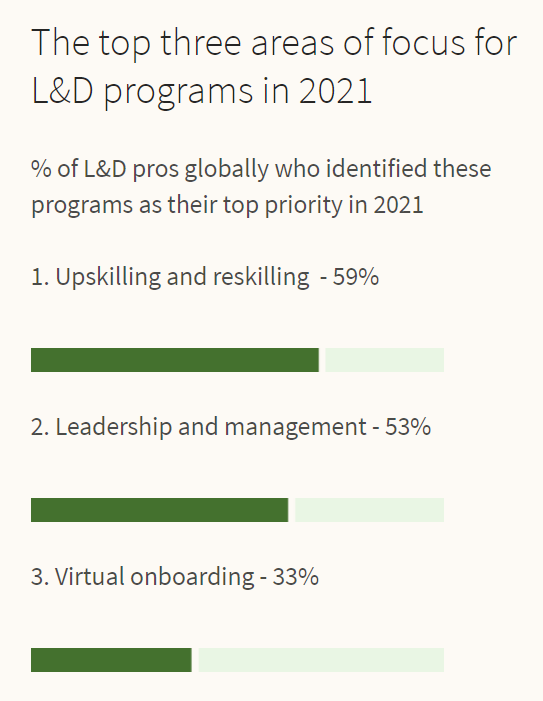
However, this is the catch: Without factoring in the business objectives, all the effort that goes into skills development and retraining can be a waste. COVID-19 has altered the way businesses function on a fundamental level. Clearly, there's an intensified need to reorganize organizational priorities and make alterations to the workforce's upskill and reskill strategies.
All in all, developing a clear connection between employee learning goals, evolving organizational objectives, and current/future job roles is the need of the hour.
- Employee retention: It's no secret that employees want to land jobs where there's scope for professional (and even personal) growth. This is why the need to upskill and reskill employees are gaining momentum. But high-performing organizations understand the importance of thinking long-term and taking their upskilling and reskilling initiatives to the next level, specifically by realigning the organizational objectives and mapping them out to the workforce's current (and future) requirements. By reinforcing a clear purpose, employees are bound to feel more committed and motivated towards the job at hand. This can boost work satisfaction, reduce employee turnover, and directly impact the company's bottom line.
For more information, you can explore imocha's blog on Reskilling and Upskilling in The Age of Digital Transformation, providing insights into the importance of continuous learning in a rapidly evolving digital landscape. - Agile work style: As per a recent survey, managers are prioritizing the need to upskill and reskill the workforce so that employees can handle organizational changes in a better capacity:
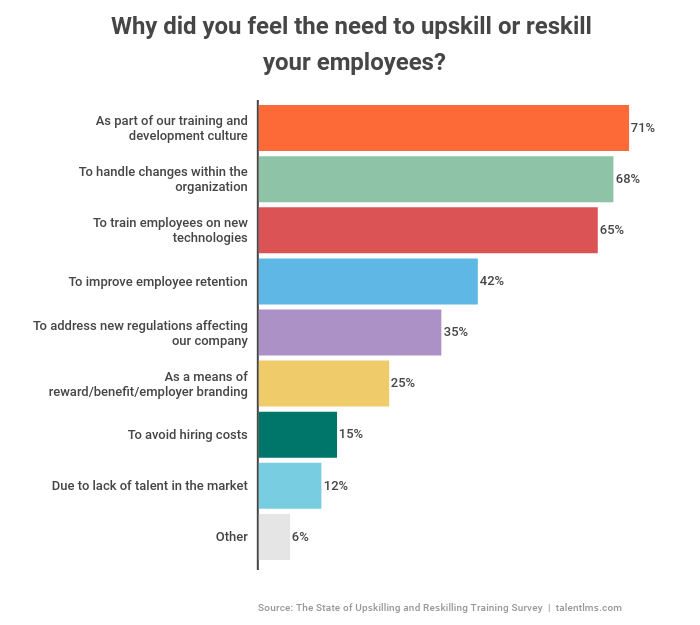
Upskilling and reskilling can help the organization to pivot with greater flexibility and agility, thereby boosting productivity and ensuring business continuity.
|
Skills not matching your role's requirements? Create a custom assessment with iMocha and hire skill fit candidates! |
A Step-by-Step Process to Upskill and Reskill Workers with Organization Goals at the Core
Here's a step-by-step lowdown on how to upskill and reskill employees without compromising on organizational goals and individual career-oriented objectives:
Step 1: Identify strategic business objectives.
The first task is to identify the business' current short and long-term goals that will be targeted by the learning programs. You should also integrate the company's vision and mission. It is necessary to understand the organizational context in terms of technological, social, economic, political, and demographic factors.
Etsy's learning and development program is an excellent example of how companies can apply internal research from diverse fields to:
- Create strategic business objectives
- Inform training best practices across the organization
- Align training with organizational development.
The brand's L&D team:
- Merges innovative learning formats with evidence-based leadership practices
- Applies research from organizational psychology, sociology, and adult learning theory and integrates Etsy's values and culture to facilitate all-round training
- Offers holistic programs, retreats, and coaching, in addition to providing online resources on varied topics - from how to invigorate a sluggish meeting to how to give difficult feedback.
The lesson: Etsy's L&D program enables employees to focus on hard and soft skills. Employees can learn and teach crucial organizational, leadership, and perseverance skills. It also empowers employees to choose their learning path and lays the foundation for employee-centric growth and development. How does this advance the organization's cause? Since the brand conducts extensive internal research on where employees might need to upskill/reskill, the training program automatically gets wired to organizational growth.
Step 2: Set S.M.A.R.T learning goals that align with the organization's overall objectives outlined in step 1.
In this step, L&D leaders need to ensure a strong and explicit alignment of training initiatives with the business goals outlined in the previous step. This can be achieved by leveraging the S.M.A.R.T framework to create Specific, Measurable, Attainable, Realistic, and Time-bound end goals. Here's an example of what a S.M.A.R.T goal looks like:
Let's say that the business objective is for the company to double its customer base in the first six months of 2022. To do this, employees will need additional training in customer support operations, such as how to improve the customer experience, how to leverage technological tools like Zoom, co-browsing, etc., to drive speedy responses.
What's important to note is that this process should be driven by internal stakeholders (think: employees and line managers) and external stakeholders (read: customers, communities, and investors) to ensure that the goals are holistic.
The lesson: Business-aligned training can help employees to:
- Understand business and performance expectations
- Operationalize the company's values, mission, and vision
- Assess the next steps related to training and drive success as well as growth
Step 3: Conduct a skills-gap analysis to assess the current talent needs.
At this stage, there's a need to assess your employee's job performance against the business goals - also known as a training needs analysis.
You will also want to review:
- The tasks and activities employees are undertaking to ensure successful goal completion
- The results needed to achieve the business strategy
At this stage, it is important to ask the following questions:
- Do employees have the requisite skills, knowledge, and capabilities to achieve the organization's end goals and vision? If not, what's missing?
- Are the existing training programs efficient in driving the required skills to successfully achieve the business goals?
By analyzing the skill-related strengths and weaknesses of your employee base, you can create an informed blueprint of learning and development efforts.
To know, what is skill gap analysis and what are the different skill gap analysis methods that help in upskilling and reskilling employees, visit here.
If you're looking for inspiration on how to start, consider Amazon's use case. The brand has invested $1.2 billion to provide 300,000 employees with access to education and skills training programs. The program, titled Upskilling 2025, aims to help employees gain in-demand skills in technical and non-technical areas and pivot to new roles without any hiccups.
The lesson: Programs like these are a win-win for the organization as well as the employee as employees get to pursue their career aspirations and get certified for key emerging skills while the company can focus on closing the internal skills gap.
|
Want to identify critical skills for organizational growth? Learn how iMocha helped Capgemini, Cognizant, TCS, Fujitsu, and other global organizations to do so! |
Step 4: Plan upskill and reskill initiatives to fill the skills gap, keeping organizational objectives in focus.
Once you've conducted a thorough skills-gap analysis, it is time to focus on creating a robust upskill and/or reskill program - one that is engaging, value-driven, relevant, customized, and convenient. You should consider the right type of training methodology such as virtual training, classroom training, eLearning, blended learning, etc.
A special mention: Managers can consider eLearning options to build an immersive and user-friendly training experience. Additionally, organizations must strive to promote bite-sized learning that's accessible on the go. This boosts employee engagement and learning comprehension.
Moreover, L&D managers should communicate the training goals and objectives with as much clarity as possible to help employees stay connected to them. This will help employees connect the dots between how their role can impact the organization's outcomes and goals positively (or negatively).
Let's look at an example to understand this well. In 2002, John Albright, the director of Leadership Development at Pfizer, took the off-beaten route - he created an L&D strategy that directly linked to business performance. Doing this helped the L&D team to analyze and measure the impact of the business objectives and training programs.
Here's why this strategy worked wonders. One, it maximized learning transfer among employees. Two, it empowered employees to clearly understand how their performance was impacting organizational outcomes. This helped employees to learn faster and better and apply their learnings to the job in an optimized manner.
The learning: Communicating the purpose of the training to the employees and the top management is as important as building a comprehensive upskill and reskill program. If the employees don't understand their role in driving the company's objectives forward, they will not be able to optimize the business' training program. After all, every new skill learned should be applied on the job and should enable the organization to inch closer towards its long-term vision.
| Dive into our curated list of the top 16 learning and development tools to revolutionize skill development and empower your workforce. |
Step 5: Measure the efficacy of the L&D programs to map out future company goals and enhance employee as well as organizational performance.
The last leg of the process is to measure the efficiency of the L&D program with respect to key parameters such as:
- Return on training investment
- Training completion rates
- Learner feedback
- Performance in training
- Training progress
The real-time feedback gathered can be used to improve future upskill and reskill training programs.
Pro tip: This step also includes fostering a culture of continuous learning where managers and leaders are always supporting employees to demonstrate their newly-learned skills. By involving C-suite executives in the training process, you can build a robust training culture - one that is management-approved (this also fosters a vote of confidence from the employees). Or else, organizations risk letting the employees fall into 'old habits,' leading to a waste of training time, resources, and assets. Additionally, L&D professionals can take their training efforts one step further by reviewing the SMART business goals and employee performance objectives outlined in step 2. By assessing the employee performance and understanding whether the business needs are being met, the organization can improvise future training programs.
Once you've measured the efficacy and ROI of the training program, you can identify future gaps in terms of roles and skills. Take a cue from SAS' learning and development program, which shines in many ways.
- The company offers learning and development programs for the 'hottest skills':
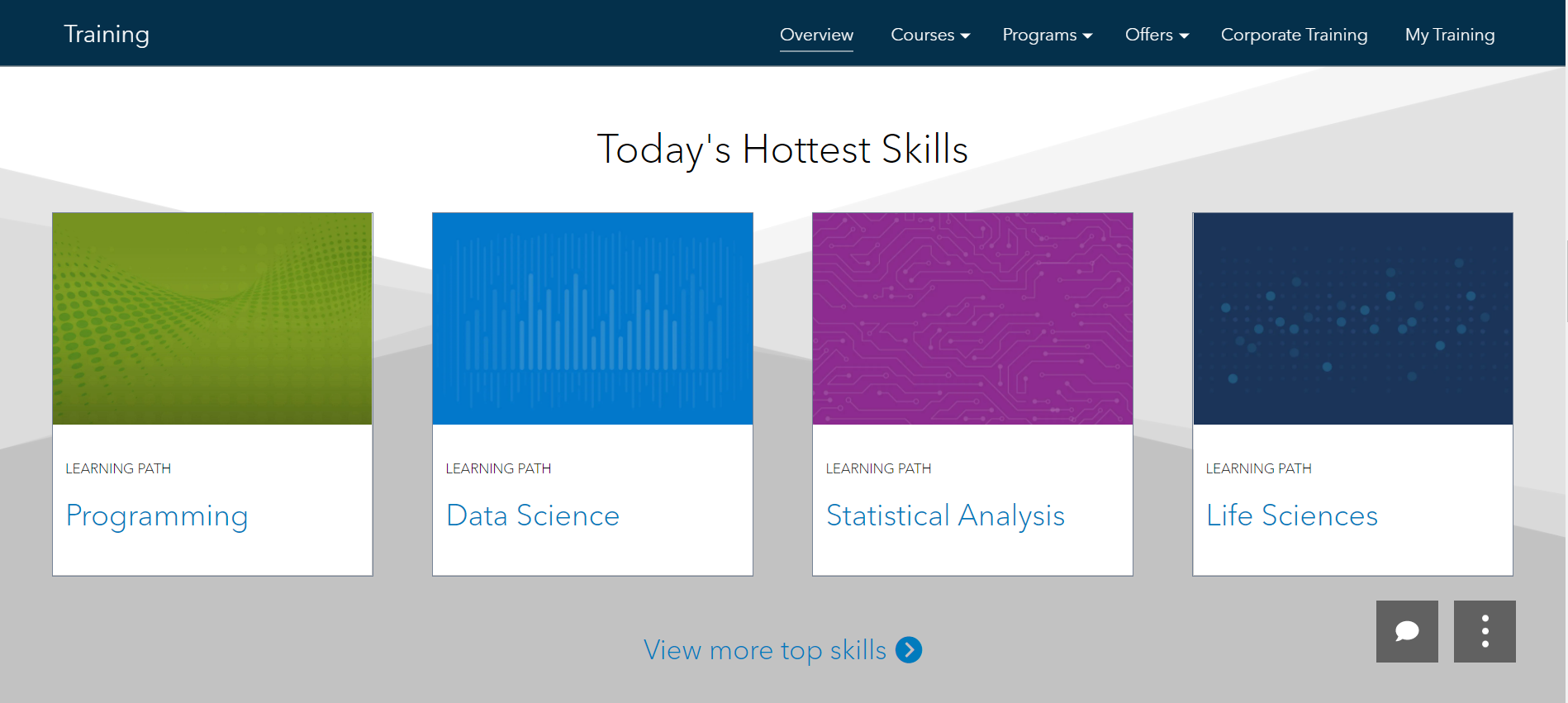
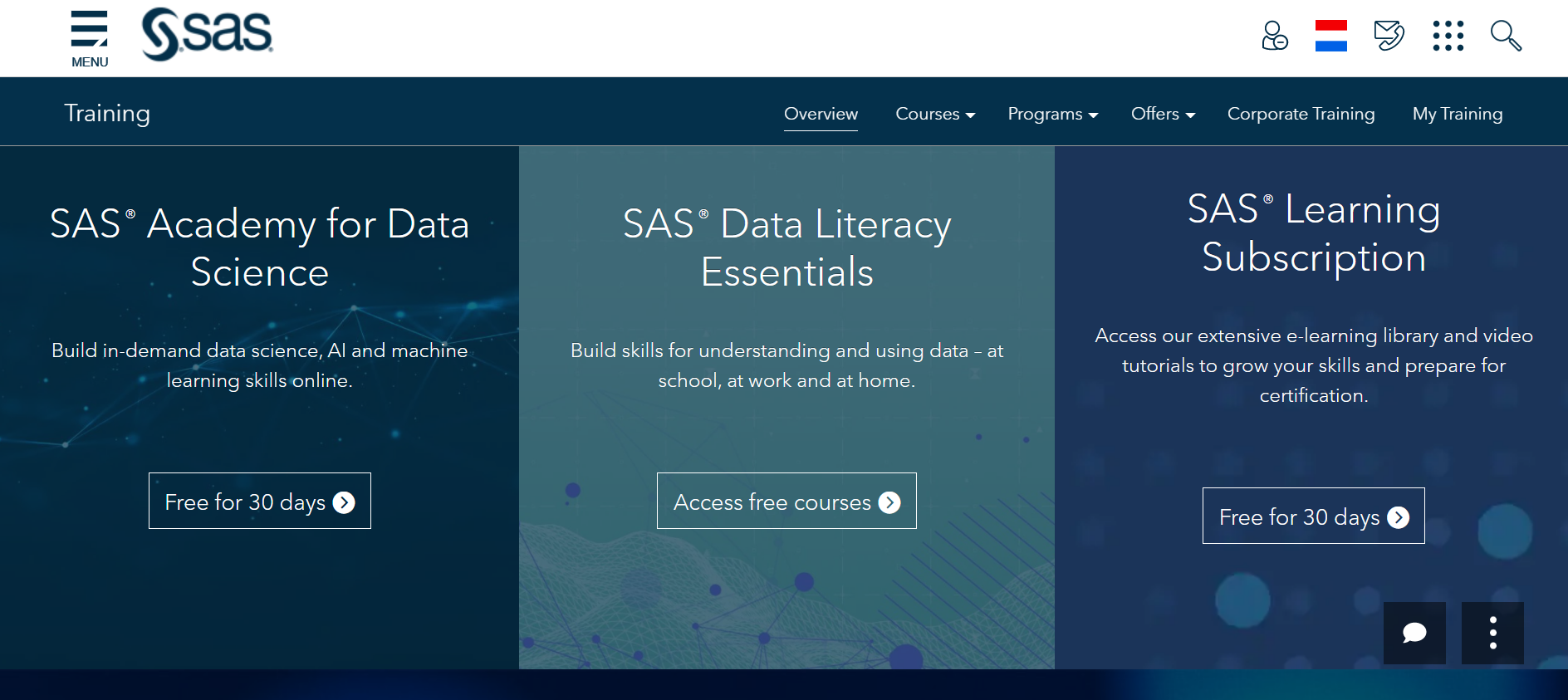
They have also devised a corporate training program to support emerging leaders:
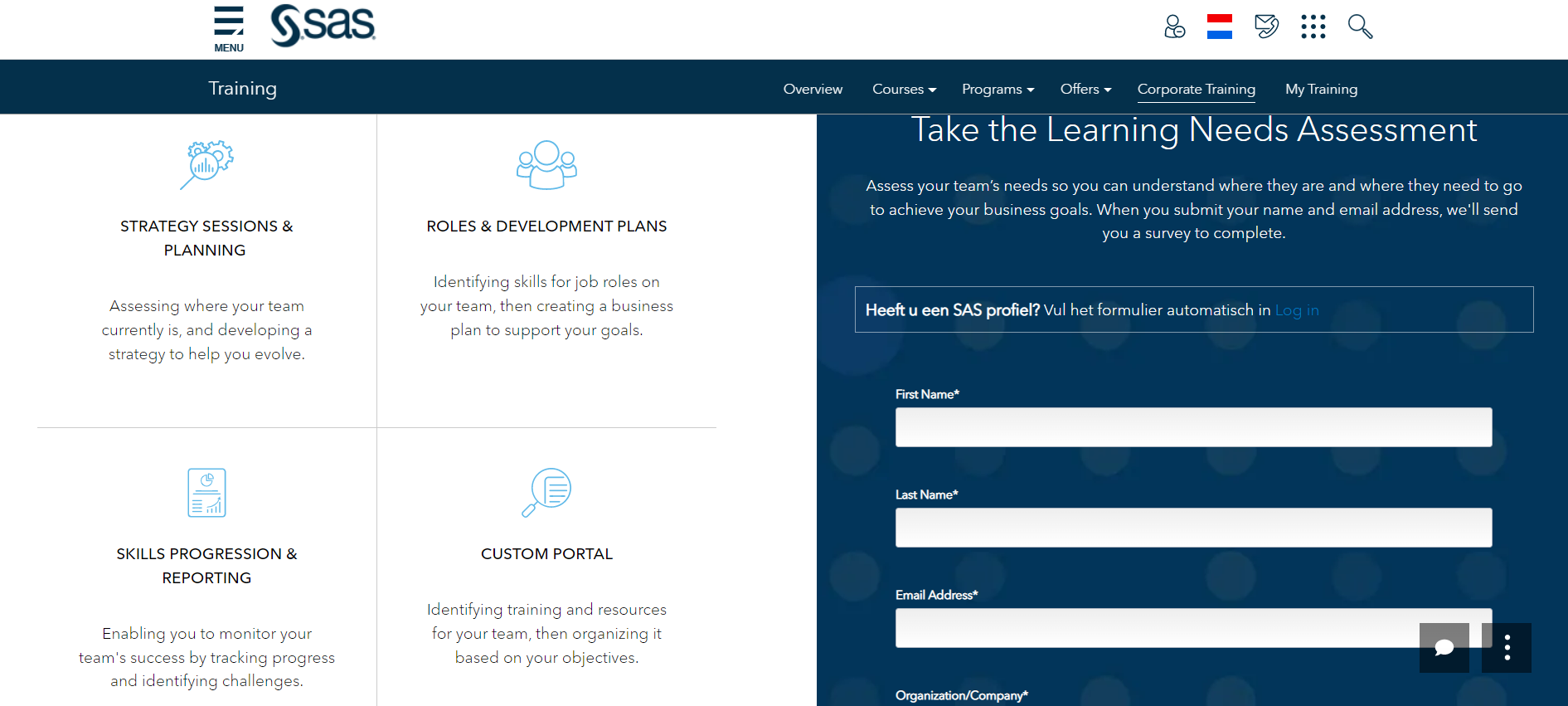
This program offers multiple benefits for the employees and the company leadership:
- Closing the skills gap: It empowers employees with the right kind of training to close the skills gap and climb the managerial ranks while meeting the business objectives.
- Customized plan: Employees get access to a customized talent development plan from the company.
- Career advancement and organizational succession: The company can help employees boost their careers while creating a reliable talent pipeline for succession planning.
The lesson: Forward-thinking L&D professionals understand the importance of planning for the future as proactively as possible. This is why measuring the L&D programs becomes an important step in an employee's learning and development life cycle.
Empower workforce growth through iMocha’s AI Upskilling and Reskilling—mapping skill gaps, guiding development, and unlocking internal career pathways.
The Bottom Line
The writing is on the wall: Investing in upskilling and reskilling employees is similar to investing in the future of your business. On the employee's side, it provides them with a sense of accountability and ownership, ultimately motivating employees to work towards fulfilling organizational goals in tandem with their individual career goals.
On the business side, it promotes a highly-engaged workforce that's driven to achieve personal and organizational goals. Without tying your L&D program to your business strategy, you'll be shooting in the dark.
Utilize imocha's blog on latest upskilling platforms to enhance your employees' skills and capabilities effectively.
To wrap up, mapping your training to the business outcomes involves five key steps:
- Identifying the strategic business objectives
- Setting S.M.A.R.T learning goals that align with the organization's outcomes
- Driving an in-depth skills-gap analysis to assess the current talent needs
- Planning upskill and reskill initiatives to fill the skills gap, keeping organizational objectives in focus
- Measuring the impact of the L&D program to chart future company goals and enhance employee as well as organizational performance
Make employee learning and development central to organizational goals, and see your employee satisfaction rates as well as company productivity and profits soar.


